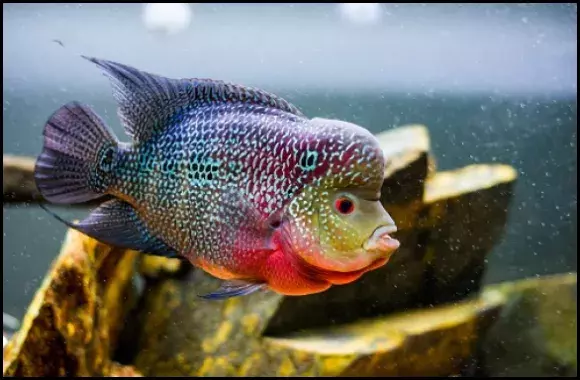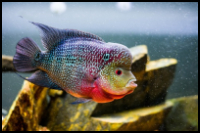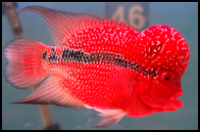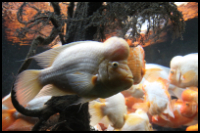





Quick Care Details (Table)
| Livestock Characteristics | Value |
|---|---|
| Care Level | Moderate |
| Temperament | Aggressive |
| Diet | Carnivore |
| Maximum Size | 12 Inches |
| Minimum Tank Size | 75 Gallons |
| Plant Safe | With Caution |
| Temperature Range | 78-82F |
| PH Range | 6.5-7.5 pH |
| KH Range | 4-8 dKH |
| GH Range | 6-16 dGH |
Species Specific Categories
Helpful Video
Care Details
Aquascape
- Hardscape: Include rocks, caves, and driftwood to create hiding spots and territorial boundaries.
- Plants: Select hardy, large-leaved plants that can withstand Flowerhorn ch behaviors.
- Open Swimming Space: Provide ample space for swimming, considering their size and territorial nature.
Substrate
- Smooth Substrate: Use fine gravel or sand to prevent injury to their sensitive underside.
- Dark Color: A dark substrate can enhance the vibrancy of their colors and reduce stress.
Disease Prevention
- Quarantine New Additions: Isolate new freshwater fish to prevent the introduction of diseases to the main tank.
- Regular Water Changes: Maintain optimal water quality to prevent stress and susceptibility to diseases.
- Observation: Monitor fish closely for signs of illness, such as changes in behavior, appetite, or appearance.
Filtration
- Efficient Filtration: Utilize a strong filtration system to handle their waste and maintain water quality.
- Mechanical and Biological Filtration: Use both mechanical and biological filtration media to remove particles and establish beneficial bacteria.
Lighting
- Moderate Lighting: These fish do not have specific lighting requirements but prefer moderate intensity.
- Provide Shaded Areas: Include floating plants or decorations to create shaded areas in the tank.
Water Flow
- Moderate Water Movement: These fish prefer gentle water flow to simulate their natural environment.
- Avoid Strong Currents: Prevent excessive aquarium water movement to reduce stress and allow them to swim comfortably.
Hardiness
- Resilient Fish: These fish are generally hardy but require appropriate care to maintain health.
- Stress Management: Maintain stable freshwater parameters and provide suitable tank conditions to minimize stress.
Acclimation
- Gradual Acclimation: When introducing these type of cichlids to a new tank, acclimate them slowly to minimize stress.
- Drip Method: Use the drip method to adjust water parameters over time before releasing them into the tank.
Special Requirements
- Territorial Behavior: Recognize their territorial nature and provide hiding spots and boundaries.
- Social Interaction: Some Flowerhorns enjoy interacting with their owners, showing personality and intelligence.
- Unique Appearance: Appreciate their distinct head bump and vibrant colors resulting from selective breeding.
Temperament and Behavior
Behavior and Social Interaction
- Intelligent Behavior: Flowerhorn cichlid are known for their ability to recognize their owners and interact with them.
- Territorial Nature: They establish territories and may exhibit aggressive behaviors toward intruders.
- Interactive Personalities: Some type of cichlids can display playful behaviors and enjoy interaction.
Aggression
- Varied Aggression Levels: Aggression can vary among individual these cichlid fish some are mild, while others are highly territorial.
- Territorial Displays: Males may flare fins, display colors, and assert dominance over their territory.
- Incompatible Tank Mates: Aggression can escalate when housed with peaceful or similar-sized freshwater fish.
Breeding
- Complex Breeding: Breeding Flowerhorn species can be intricate due to their hybrid nature.
- Careful Pairing: Selecting compatible pairs and monitoring their behaviors is crucial for successful breeding.
- Bubble Nest Building: During courtship, males create bubble nests to house fertilized eggs.
Compatibility
- Selective Tank Mates: Choose tank mates carefully, focusing on compatible and similarly sized fish.
- Avoid Small or Shy Fish: Smaller or timid freshwater fish can become targets for Flowerhorn aggression.
- Solitary or Select Grouping: Flowerhorn cichlid can be solitary or kept with a few compatible tank mates.
Activity Level
- Active Swimmers: Flowerhorn cichlid are active and dynamic swimmers, utilizing the full tank space.
- Exploration: They enjoy investigating their surroundings and may rearrange decorations.
Clean Up Crew
- Limited Role: These cichlid fish are not efficient at cleaning up debris or uneaten food.
- Regular Maintenance: Perform regular freshwater changes and maintenance to keep the tank clean.
Schooling or Shoaling Behavior
- Solitary Nature: Flowerhorn cichlid are solitary fish and do not exhibit schooling or shoaling behaviors.
- Avoid Crowding: Do not keep multiple Flowerhorn cichlids together, as aggression may escalate.
Diet and Nutrition
Dry Foods
- High-Quality Pellets: Opt for specially formulated pellets for cichlid fish, ensuring they meet nutritional needs.
- Balanced : Choose pellets that contain a mix of protein, vitamins, and minerals for overall health.
- Variety: Offer different types of pellets to prevent monotony and encourage appetite.
Frozen Foods
- Variety of Choices: Provide frozen treats like bloodworms, brine shrimp, and daphnia.
- Nutritional Boost: Frozen foods offer essential nutrients and mimic natural prey items.
Live Foods
- Occasional Treats: Feed live foods like blackworms, crickets, or small feeder fish occasionally.
- Nutrient-Rich: Live foods are highly nutritious and can stimulate natural hunting behaviors.
Vegetables
- Limited Vegetables: Flowerhorn fish are primarily carnivorous, but they might nibble on blanched spinach, zucchini, or peas.
- Supplemental Treats: Use vegetables as occasional treats to diversify their diet.
Algae
- Minimal Algae Consumption: These fish will not eat algae.
- Focus on Protein: Their diet should primarily consist of protein-rich foods.
Feeding Schedule
- Regular Schedule: Feed these fish 2-3 times a day, in quantities they can consume within 2-3 minutes.
- Consistent Timing: Stick to a consistent feeding schedule to establish a routine.
Supplemental Foods
- Occasional Treats: Offer treats like freeze-dried insects or small crustaceans occasionally.
- Enhance Color: Some color-enhancing supplements can intensify their vibrant hues.
Tank Parameters
Tank Size
- Minimum Tank Size: A tank with a capacity of 75 gallons or larger is recommended.
- Space for Territory: These fish need ample swimming space and territories to establish.
Tank Length and Measurements
- Length Consideration: Choose a tank with dimensions around 48 inches in length to accommodate their swimming habits.
- Vertical Space: Vertical space is important due to their territorial nature and head bump.
Species Maximum Size
- Size Range: Flowerhorn fish can grow between 12 to 16 inches, depending on genetics and care.
- Provide Room to Grow: A spacious tank is crucial to accommodate their potential adult size.
Water Temperature
- Ideal Range: Maintain aquarium water temperature between 78-82°F (25-28°C).
- Stable Temperature: Avoid drastic aquarium temperature fluctuations to prevent stress.
pH (Acidity/Alkalinity)
- pH Range: Keep pH levels within the range of 6.5-7.5.
- Monitor Stability: Maintain stable pH to prevent stress and fluctuations.
KH (Carbonate Hardness)
- Carbonate Levels: KH should be around 4-8 dKH.
- Stable Levels: Stable KH helps maintain stable pH and water chemistry.
GH (General Hardness)
- General Hardness: GH levels of 6-16 dGH are suitable.
- Consider Local Water: Mimic the natural water conditions the Flowerhorn cichlid is accustomed to.
Nitrate (NO3) Levels
- Control Nitrate: Keep nitrate levels below 20 ppm.
- Regular Water Changes: Frequent aquarium water changes help manage nitrate levels.
History, Popularity, History and Species Variety Details
The History, Popularity and Habitat
History:
The Flowerhorn fish, scientifically known as Amphilophus citrinellus x Vieja synspila, is a captivating hybrid that originated from deliberate crossbreeding efforts in the late 20th century. The specific origins of the Flowerhorn's hybridization are not definitively known, but it is believed to have been created in Malaysia, Thailand, or Taiwan. The exact parentage of the hybrid remains a subject of debate among aquarists and experts.
The breeding of Flowerhorn species involves selective crossing of cichlid species, incorporating features from various fish to create a visually striking and unique fish. The aim was to produce vibrant colors, distinctive head bumps, and engaging personalities. This process resulted in a fish that quickly gained attention and popularity within the aquarium hobby.
Popularity:
The Flowerhorn fish skyrocketed to fame in the early 2000s due to its remarkable appearance and intriguing behaviors. Its vibrant colors, prominent nuchal hump, and apparent ability to interact with humans drew aquarists' interest worldwide. Social media platforms and online communities further fueled its popularity, with enthusiasts sharing images and stories about their Flower horns.
However, the Flowerhorn's popularity has also sparked debates and discussions within the hobby. Some critics argue that the creation of hybrids through selective breeding raises ethical concerns, as it involves altering natural genetic diversity. Nevertheless, Flower horns have continued to capture the fascination of fishkeepers around the world, leading to various strains and color variations.
Habitat:
In the wild, the parent species of the Flowerhorn, Amphilophus citrinellus and Vieja synspila, inhabit freshwater ecosystems across Central America. These species are found in lakes, rivers, and streams with varying freshwater conditions. Their natural habitats are characterized by warm water temperatures, moderate water flow, and a mix of rocky and sandy substrates.
Flowerhorns, as hybrids, do not have a specific natural habitat. Instead, they inherit traits from their parent species' habitats. This adaptability makes them versatile aquarium inhabitants, capable of thriving in a range of water conditions and setups. As a result, aquarists have the opportunity to create environments that suit their fish needs while offering ample space for their growth, territorial behaviors, and engaging interactions.
In conclusion, the history of the Flowerhorn fish is a tale of human-guided hybridization, aimed at creating a visually captivating and interactive aquarium fish. Its popularity has soared due to its unique appearance and engaging behaviors, although ethical debates surrounding hybridization persist. While the Flowerhorn does not have a natural habitat of its own, it inherits traits from its parent species' native environments, making it a fascinating and adaptable addition to aquariums around the world.
Variations In The Flowerhorn Fish Species
Kamfa:
- Recognized for its distinctive head bump and vibrant colors.
- Kamfa Flowerhorn fish often have intricate patterns and markings on their bodies.
- Their appearance can vary widely, with some displaying intense reds and others showcasing metallic shades.
Thai Silk:
- Known for their shimmering, iridescent scales that resemble silk fabric.
- Their scales have a unique reflective quality, giving them an ethereal appearance.
- Thai Silk Flowerhorn fish come in a range of colors, from metallic blues to fiery reds.
Zhen Zhu :
- Noted for its vibrant red coloration and pearlescent scales.
- Zhen Zhu Flowerhorn fish are bred to have a consistent and intense red hue.
- Their name "Zhen Zhu" means "precious pearl" in Chinese, alluding to their lustrous appearance.
Golden Base:
- Characterized by a golden or yellow base color with contrasting markings.
- They often display intricate patterns and a mix of metallic and matte scales.
- The golden base adds a unique and attractive dimension to their appearance.
Faders:
- Fader Flowerhorn fish are bred to display color-changing abilities.
- Their colors can intensify or fade depending on factors like mood, lighting, and temperature.
- This variation adds an element of surprise and intrigue to their appearance.
King Kong Parrot :
- A hybrid that combines characteristics of Flowerhorn and Parrotfish.
- Known for their beak-like mouths, which resemble those of parrotfish.
- King Kong Parrot Flowerhorn fish species often have striking color patterns and unique shapes.
Super Red Dragon:
- Renowned for their deep and intense red coloration.
- These Flowerhorns showcase rich red shades, giving them a regal and striking appearance.
- The Super Red Dragon variation is highly sought after by enthusiasts.
Short Body Flowerhorn:
- Bred for their compact and short body shape.
- Their shorter bodies give them a distinctive appearance within the Flowerhorn family.
- Short Body Flowerhorns often display vibrant colors and unique patterns.
Common Tank mates For The Flowerhorn Cichlid
Convict Cichlid: Hardy and small, they can hold their own against aggressive fish.
Silver Dollar Fish: Peaceful and silver-scaled, they contrast well with aggressive fish.
Firemouth Cichlid: Similar size and temperament, creating a lively tank dynamic.
Jack Dempsey Cichlid: Can handle the Flowerhorn's assertiveness, but monitor for aggression.
Severum Cichlid: Peaceful and colorful, they add variety to the tank.
Plecostomus (Common Plecos): Bottom-dwelling algae eaters that usually don't provoke aggression.
Bichirs: Predatory fish that can coexist due to their less territorial nature.
Silver Shark (Bala Shark): Active and schooling fish that can tolerate Flowerhorn's presence.
Black Ghost Knifefish: Nocturnal and peaceful, they occupy different parts of the aquarium.
Tinfoil Barb: Active and fast-swimming, they can avoid conflicts with Flowerhorn cichlid.
can you give me steps on how to tell this fishes gender
Male gender vs Female gender (Sexual Dimorphism)
Male:
- Head Bump: Males typically have a larger, more pronounced head bump (nuchal hump) than females. The bump is located on the forehead between the eyes and can vary in size and shape depending on the strain.
- Vivid Colors: Male Flowerhorns often exhibit more intense and vibrant colors. These colors can include shades of red, orange, blue, and green.
- Fin Extension: Males may have longer and more extended dorsal and anal fins compared to females. These fins can display intricate patterns and coloration.
- Territorial Behavior: Males are more territorial and aggressive, especially during breeding periods. They establish and defend territories within the tank.
- Body Shape: Males tend to have a more streamlined and elongated body shape, emphasizing their growth potential.
Female:
- Smaller Head Bump: Females generally have a smaller and less prominent head bump compared to males. It might be less pronounced and flatter.
- Subdued Colors: Female Flowerhorns typically display less intense and vibrant colors compared to males. Their colors might be more muted.
- Shorter Fins: Female Flowerhorns often have shorter and less extended dorsal and anal fins than males. These fins might have simpler patterns.
- Less Territorial: Females are usually less territorial and aggressive compared to males, although they can become territorial during breeding.
- Rounder Body Shape: Females tend to have a rounder and fuller body shape, particularly in the abdominal area.
Breeding The Flowerhorn Fish
Pre-Breeding Preparation:
- Select Healthy Breeding Pairs: Choose mature Flowerhorns with desirable traits from reputable sources. Consider compatibility, coloration, and head bump size.
- Conditioning: Feed the chosen pair high-quality foods rich in protein to ensure they are in optimal health and condition for breeding.
- Separation: Place the male and female Flowerhorns in separate tanks to reduce aggression and prepare them for breeding.
Breeding Setup:
- Spawning Tank: Set up a separate tank (breeding tank) with proper filtration, aeration, and hiding spots. Use a substrate that's easy to clean.
- Temperature and Water Conditions: Maintain water temperature between 80-82°F (27-28°C) and ensure clean, well-aerated freshwater. Keep pH around 7.0-7.5.
Introducing the Pair:
- Introduce the Female: Place the female Flowerhorn in the breeding tank first. She will explore and choose a suitable spawning site.
- Introduce the Male: Introduce the male Flowerhorn after the female establishes her territory. Observe their behavior for compatibility.
Courtship and Spawning:
- Male's Display: The male will display vibrant colors, expand his fins, and often show off his head bump to attract the female.
- Nuchal Kiss: The male might approach the female and press his head bump against her abdomen in a behavior known as "nuchal kiss."
- Egg Laying: Once the female is receptive, she may lay eggs on a clean, flat surface, such as a rock or a smooth PVC pipe provided in the tank.
Incubation and Care:
- Fertilization: As the female lays eggs, the male will follow and fertilize them. The process might take several hours.
- Egg Collection: After spawning, you can collect the eggs and transfer them to a separate incubation tank to protect them from potential predation.
Egg Care and Hatching:
- Incubation Conditions: Maintain stable water conditions with optimal temperature, aeration, and low light. Provide gentle water movement to prevent fungal growth.
- Hatching: The eggs will hatch within a few days. The fry will initially attach to the substrate using an adhesive organ called an egg spot.
Raising Fry:
- Initial Food: Feed newly hatched brine shrimp or specialized fry foods to the tiny fry, ensuring they receive proper nutrition.
- Gradual Growth: As the fry grow, introduce larger foods such as microworms, baby brine shrimp, or finely crushed pellets.
- Fry Tank Maintenance: Regular freshwater changes, maintaining water quality, and providing suitable hiding spots are crucial for fry development.
Weaning and Growth:
- Transition to Solid Foods: As the fry grow, gradually introduce finely crushed pellets or powdered foods suitable for their size.
- Social Interaction: Keep fry together to encourage natural behavior and socialization.
Gradual Separation:
- Separating Fry: When the fry reach a suitable size and show signs of growth and independence, you can consider separating them into individual tanks.
Frequently Asked Questions
Can Flowerhorns recognize their owners?
Flowerhorn fish can display recognition behaviors and interact with their owners, especially during feeding time.
Can Flowerhorns breed in home aquariums?
Yes, Flowerhorn fish can be bred in home aquariums with proper setup, conditioning, and care. Breeding pairs should be introduced and observed closely.
What's the lifespan of a Flower horn?
With proper care, Flowerhorn cichlid can live around 10 to 12 years or even longer.
What's the significance of the head bump on a Flower horn?
The head bump, or nuchal hump, is a distinct feature often larger in males. It's believed to be a sign of maturity and can vary in size and shape based on genetics and strain.
Can Flowerhorns be kept with other fish?
Flowerhorn fish have varying levels of aggression. Some compatible tank mates include similar-sized cichlids, plecos, and peaceful schooling fish.
Are Flowerhorns aggressive?
Yes, Flowerhorn species can exhibit territorial and aggressive behavior, especially during breeding. Tank mates should be chosen carefully to avoid conflicts.

